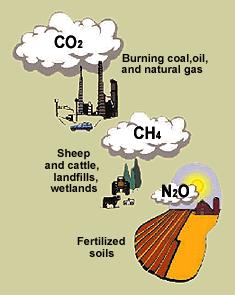| ||||||||||||||||||||||||||||
Proactive disclosure Print version |  The winds of change: Climate change in Prairie Provinces Why is the climate changing now? Earth's solar energy budget About one third of the incoming short-wave radiation from the Sun is reflected back into space by the atmosphere and the Earth's surface. The remainder is absorbed by the Earth and its atmosphere. The heat-trapping quality of the atmosphere, the so-called 'greenhouse effect', is caused by gases such as carbon dioxide (CO2) and water vapour that absorb long-wave radiation emitted by the Earth. The greenhouse effect is essential for maintaining temperatures within a range that is tolerable for most life on Earth.
The great CO2 buildup Global CO2 concentrations in the atmosphere have increased 30% since the start of the Industrial Revolution in the 1700s. The cause of the rapid buildup of CO2 is human activities: burning fossil fuels (coal, oil, and natural gas), agricultural practices, and deforestation. Scientists predict that atmospheric CO2 concentrations will double from pre-industrial levels in the next 40 to 60 years.
The carbon balance
Carbon occurs in the atmosphere and oceans mainly in the form of CO2. Huge amounts of carbon are also stored within the Earth in fossil fuels and sedimentary rocks, and on the Earth's surface in vegetation and soils. Before the Industrial Revolution atmospheric concentrations of CO2 and other greenhouse gases did not vary much because additions were balanced by removals. Greenhouse gases: the big three The main energy-absorbing or greenhouse gases, aside from water vapour (H2O), are carbon dioxide (CO2), methane (CH4), and nitrous oxide (N2O). Methane and nitrous oxide absorb more long-wave radiation than CO2, but CO2 has the greatest impact because it is much more abundant. 
References Hengeveld, H., 1995: Understanding Atmospheric Change, Second Edition, State of the Environment Report Number 95-2, Environment Canada, p. 26. Houghton, J.T., Meira Filho, L.G., Callander, B.A., Harris, N., Kattenberg, A., and Maksell, K. (Ed.), 1995: Climate Change: the Science of Climate Change; Cambridge University Press, London, United Kingdom, 572 p.
|